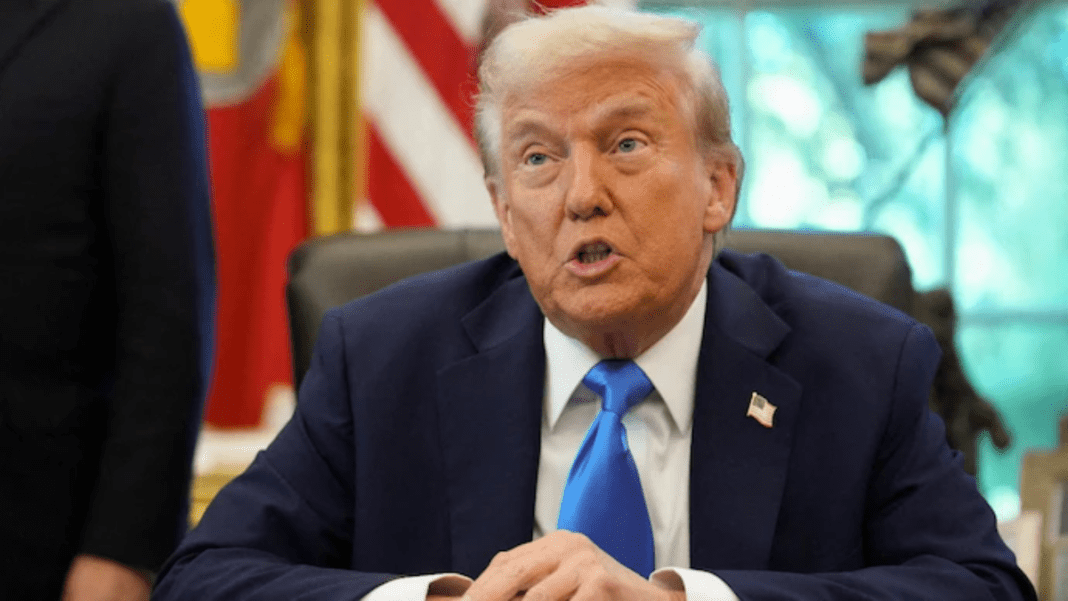Pressure is rising in Washington as US President Donald Trump speaks more openly about using tough military actions against drug cartels. His most striking comment came during a briefing with reporters, when he said that bombing cartel targets in Mexico was “possible” if that is what it takes to stop the flow of illegal drugs into the United States.
Trump Presses Mexico as Cartel Threat Draws Tougher US Stance
Trump said he supported “whatever it takes to stop the flow of drugs,” and he did not hide his frustration with what he called Mexico’s weak efforts in tackling dangerous criminal groups. His remarks quickly spread across American media and were also highlighted by international outlets.
The United States has already labeled several Mexican cartels as foreign terrorist organizations. This label gives Washington expanded legal powers and could, in theory, allow military-style actions normally used against global terror networks.
The following sections break down the situation in simple, easy-to-understand language suitable even for young readers, while keeping the article accurate and factual.
Rising Pressure and Mexico Military Planning Leaks
In early November, NBC News reported that Trump officials had examined possible military actions inside Mexico. Unnamed White House insiders said officials discussed potential ground operations. They also said the discussions included ideas such as using drone strikes against high-ranking cartel members and hitting cartel-linked drug labs.
Although officials did not confirm these plans, the leak sparked intense debate in both the United States and Mexico. Many people questioned how Mexico would respond if a foreign military crossed its borders, even in the name of fighting crime. The idea that US forces might enter Mexico made headlines because Mexico has a long history of rejecting foreign military involvement on its soil.
U.S. drops hammer on Mexico’s casino underworld as sanctions hit 27 cartel-linked targets
At the same time, US officials tried to calm the situation. Secretary of State Marco Rubio said the United States was working “more closely than ever” with Mexico to counter drug trafficking. He stressed that Washington did not plan any “unilateral actions,” meaning the United States would not move forward without Mexico’s involvement.
Despite these assurances, Mexico remained at the center of the discussion because Trump’s own remarks about bombing cartel targets kept the debate alive.
New Campaign “Southern Spear” and Rising Speculation
While talk of Mexico continued, the United States also expanded military activity in nearby regions. US forces were ordered to target vessels in the Caribbean and the Pacific that officials said were carrying “narco-terrorists.” These actions signaled a larger campaign stretching far beyond Mexico’s borders.
Around the same time, Washington expanded its military presence near Venezuela. Trump ordered a Navy strike group led by the USS Gerald R. Ford, carrying thousands of personnel and aircraft, which sparked speculation about possible future missions in the region.
Some analysts questioned whether Washington’s buildup near Venezuela connected to US discussions about cartel activity in Mexico, though officials did not confirm any link. CNN reported that Trump had not approved any ground operation in Venezuela. White House sources said the administration had made no final decision despite the deployment. Trump also stated that he was open to holding direct talks with Venezuelan President Nicolás Maduro.
Tensions grew when US Defense Secretary Pete Hagset launched “Southern Spear,” a new campaign targeting “narco-terrorists” across the Western Hemisphere. His announcement fueled additional speculation about whether the United States might include Mexico because of its central role in drug trafficking routes.
Across the region, concerns increased as people in Mexico feared the United States might act without permission, while some officials in Washington argued that the country needed tougher steps to curb cartel violence.
Trump remained firm, stating that bombing cartel targets in Mexico was “possible,” a comment that kept Mexico at the center of global attention. For now, Mexico remains closely tied to the debate over how far the United States might go in its campaign against drug cartels.
